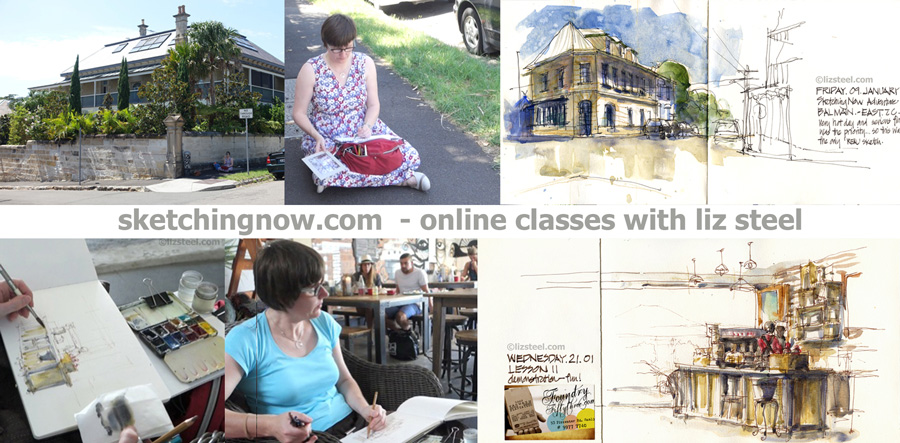
This is the first part of a series of posts reviewing my SketchingNow Foundations Online Course: The other articles in the series are here
Part 2: Beginning the Sketch and Balancing Line and Colour
Part 3: Heading out on Location
A few weeks ago my first SketchingNow course – Foundations – finished and all I can say is that it turned out to be bigger in every possible way than I ever imagined!
So I just wanted to share with everyone that follows my blog, a few reflections on the background to the concepts that were included in the course, and how great it was to be able to share these through an online class.
I have been developing the framework of how to sketch in a spontaneous way for the last few years, and in many ways, a 12-week online class was the perfect format to crystallise it. It gave me time to ‘do it properly’
Putting the material together was a LOT more involved than I expected even though I knew beforehand that it would be a heap of work. My videos got longer and more involved each week and when I started to commit my ideas to the page I knew they needed to become more precise and descriptive. Ah! but that is exactly what I felt I needed to do – I wanted to lay this foundation well! It was crazy to try to put all the content together during the period of the course, but I loved the energy that this created. I was also able to tweak the content as I went along in response to what had come up in the previous weeks.
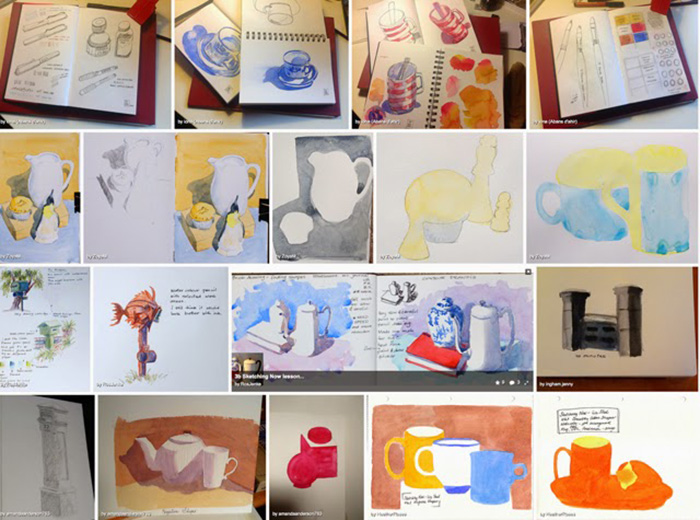
I loved being able to share my approach with a big group from all over the world, I loved seeing their work, answering their questions, reading the discussions. I especially loved feeling as if I was looking over their shoulder when they had light bulb moments. That was really really special! Not to mention all the encouraging and exciting feedback!
Thank you to a few important people:
I have mentioned that Chantal Vincent helped me with the videos when I was out on location – thank you again! Thanks also to my dad, who helped me on a few occasions when I needed a hand with my videoing myself during the studio demonstrations and to my mum for all that final proofreading. Not to mention the constant support I always receive from my wonderful family!
But I have to make a very special thank you to Chris Haldane. Not only is Chris a great sketching friend, and someone who is great to discuss art concepts with, but she is a GREAT copy editor. Every Monday night we would have a long phone conversation (averaging 2 hours?) going through my handout, reading it aloud and tightening the structure and the sentences. It was not just the handout content though, we often discussed the concepts as they related to our work right now and one week, when we did our review face to face after dinner, we went through one her of amazing travel sketchbooks, applying that particular lesson’s ideas to her recent work. So a huge huge thank you Chris! Putting the handouts together was one the biggest hurdles each week, and to have so much fun going through them was very special Please pop over to her Flickr and check out her beautiful work – and say hi!
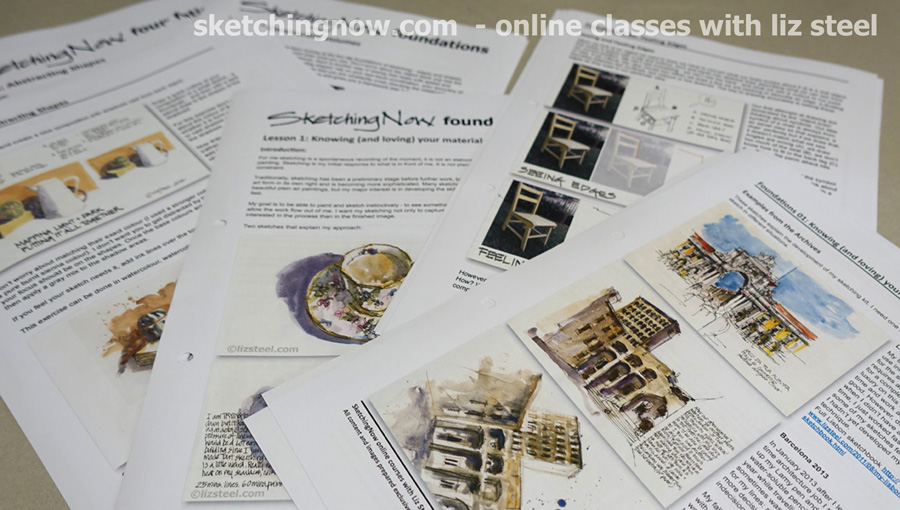
When I started teaching regularly (just under 2 years ago – hard to believe that it is not longer than that!) I spent a lot of time researching various approaches to teaching drawing and painting. My architectural background meant that I came into ‘art’ from a different direction. The result of this research was an ‘amused confused’ state! For something that is so subjective, it amazed me how many rules artists have and how completely contradictory many of them are! Not that I was trying to find the ‘right’ way, but I was looking for a framework that tied it all together. At this time I was given the best advice from my great sketching friend Paul Wang:
Teach what you know and share from the heart.
That sums up so well what I have tried to do ever since!
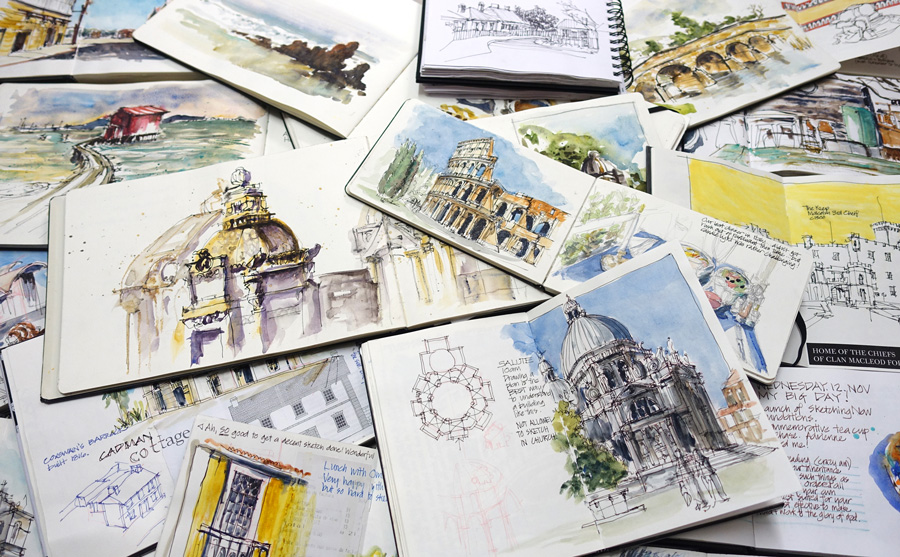
So I closed all the art books and reached for my own sketchbooks! I started looking at how I had done things over the years and it surprised me how many different methods and techniques I found in my own work. One of the big themes I saw was the fusing of an architectural background with art principles. The other big issue was TIME. This has a huge impact on the way that I work, and I believe is the main difference between sketching and a more traditional drawing/painting approach that is described in most of the instructional books on the market.
Over the last 18 months I have been refining a framework that distills the essence of the way I work. Coming from a more architectural design background, I have never been convinced that ‘just draw what you see’ was an adequate enough direction. As an architect I just don’t want to draw what I see, I want to understand it.
For me, the term ‘visual THINKING’ is much more helpful than just ‘learning to see’. If you can think about the object in a visual way, you can draw it. To really ‘see’ something in a way that you can draw it , you must have a certain conversation in your head. Anyway… as you are all aware, I could go on all day, so I will cut to the quick and share my Three Ways of Visual Thinking:
- Feeling Edges
- Abstracting Shapes
- Constructing Volumes
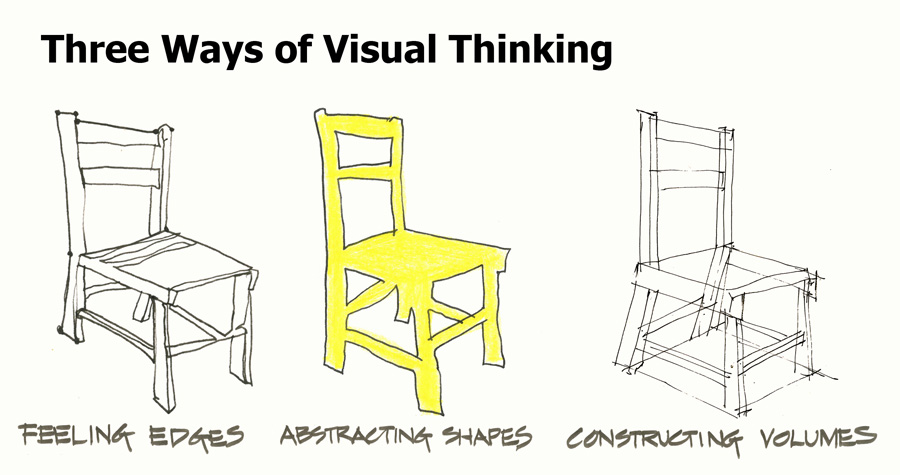
Inserting the words “feeling”, “abstracting” and “constructing” in front of edges, shapes and volumes just made everything click into place. It has become a powerful framework that helps in many different situations.
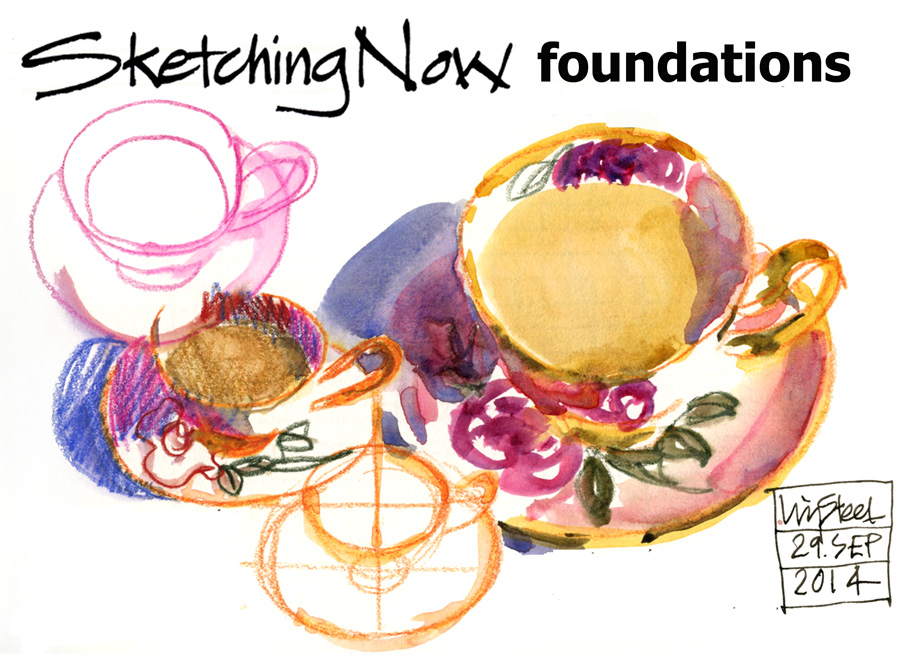
In a funny way, one of the reasons why I love sketching teacups so much is that it gives me the chance to play with these three approaches. This sketch which I used for the Foundations course shows that – sometimes I use one way, sometimes two and other times all three.
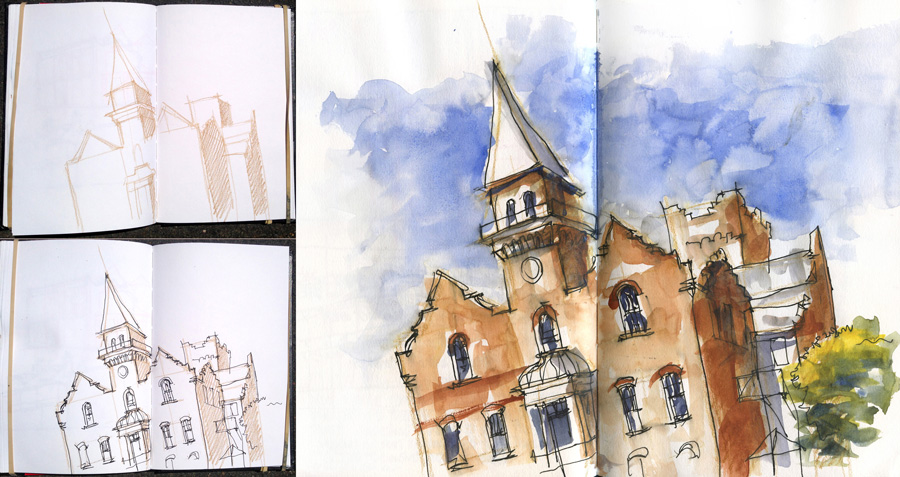
I was (and still am) in love with line: I love the tactile nature of following edges with my eye and letting my hand follow in sync. Painters used to say to me that I needed to work with shapes and I found that unsatisfying as I lost the tactile experience – that is until I realised that it was a different way of thinking. Using shapes is a more abstract way to see, distancing yourself from the subject, squinting and reducing complex objects to simple shapes. And as for constructing volumes… hmm, so many artists don’t understand perspective but really I believe that the core skill is the ability to be able to see objects as volumes in 3D space. Constructing volumes is not as critical as the other two, and many artists discourage thinking in that way, but I believe it is essential to develop this skill if you want to sketch spontaneously but yet with accuracy. If you can understand the volumes or the structure of an object, you can draw far quicker than by working from one edge to the next. I have many more ideas that I want to develop down this track….
During the course of putting the content of the Foundation course together, I began to see more and more ways of using this framework in the work that I am doing now… and that is very exciting. It reinforced the idea I have had of my creative journey. Below is a diagram that I had intended to share BEFORE the course, as a lead-up to it, but I only got around to drawing it for the last lesson.
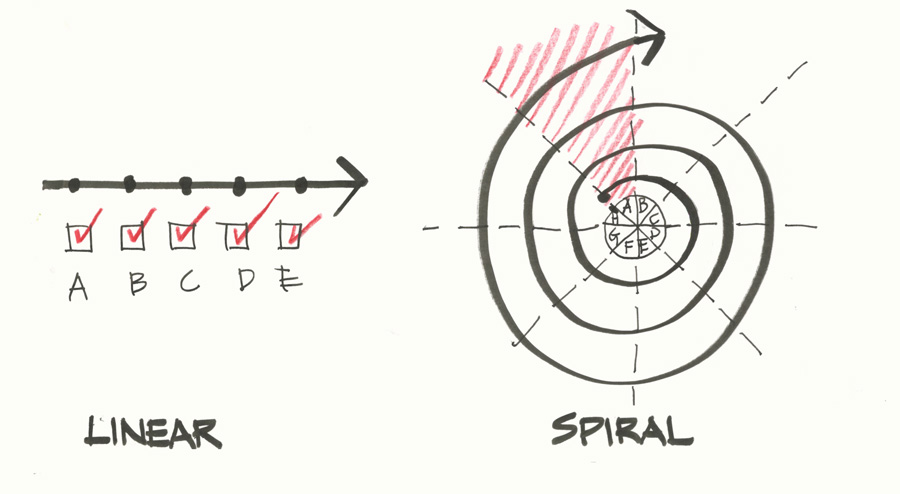
Learning to draw and paint is a complex process. What we are trying to do is to learn a new language and absorb concepts to such a degree that they become second nature. So it is not just a matter of a linear process where we tick off each item as we go. “Got that, nailed that, let’s move on!” Instead, I see my creative journey as a spiral that is progressively expanding outwards. I am continually revisiting the core concepts, each time with a richer understanding and deeper application. I never move on from these core essential concepts.
I was intending to write more, but this blog post is long enough! I will continue this review of Foundations in another post (or two!) And, if you are wondering, I am looking at ways of re-offering the Foundations Course in a few month’s time.
This is the first part of a series of posts reviewing my SketchingNow Foundations Online Course: The other articles in the series are here
Part 2: Beginning the Sketch and Balancing Line and Colour
Part 3: Heading out on Location
Subscribe to my mailing list for my monthly newsletters including first notification of my new SketchingNow Online Sketching Courses and face-to-face workshops.




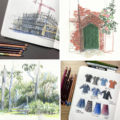
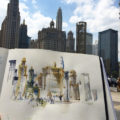
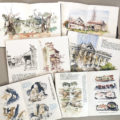
14 Comments
will do Sherry- would love to have you join!
thanks Alissa- miss having you around although I did not have time during the course for social catch ups at all. looking forward to catching up on all your adventures soon!
thanks Gabriella – will keep you posted!
thanks Katie …. hoping to have a break first!!!
It would be wonderful if I can do the next foundations course. Please do give notice on your blog, Liz! I definitely need the help!
That was wonderful to read Liz. I know that you put so much time and hard work into your courses and it was great to hear about the other very important people involved. I wish that I had been there to share so of the journey, although it sounds like you were so busy that we may not have caught up at all. I am so proud to have been there at the beginning of it all and to see the direction it is heading
I am looking forward to the course too.
Liz I think it is a easy course to re-offer. You have it all done and you just have to show up for it to answer questions. It might be easier than what you went through with us, and as you might be a bit more relaxed (not so stressed about keeping up with videos and so forth) it might even be better with more interaction. You also might think about asking those of us that took your course for feedback.
Every bit of your extensive, hard work was evident in Foundations! I was (am) a newbie to sketching, and I learned SO much during this course. Due to illness and travel, I wasn't able to keep up at the end, but I am still working on the last three lessons, and will be revisiting many of the previous ones. I think of your concepts every time I pick up a pen to sketch. I'll be first in line for the next course, hopefully with many weeks of practice between the two. Thanks, Liz, it was a wonderful course!
I will sign up for the next round of this course,,,,can't wait…..I hope you will give us atleast a months notice or so as I want to clear my schedule….looking forward to it.
thanks Karen – that is go great to hear! See you next time!
great Cynthia – yes at least a months notice!
Is this a course appropriate for someone completely new to sketching or any kind of drawing? It seems to be oriented towards people who already have a familiarity/experience with art and will help then explore move along. I, on the other hand, can pick up a pencil/pen and write fluidly and expressively–but attempting to do "art" with the same instrument never turns out well…I'm not quite sure how to begin. But I have the desire!
HI Tonya – sorry I somehow missed your comment. Sorry!
Yes, the course is suited for a beginner…I start at the very beginning and explain how to see!
NEWSLETTER
Subscribe for first notification of workshop + online classes and more.